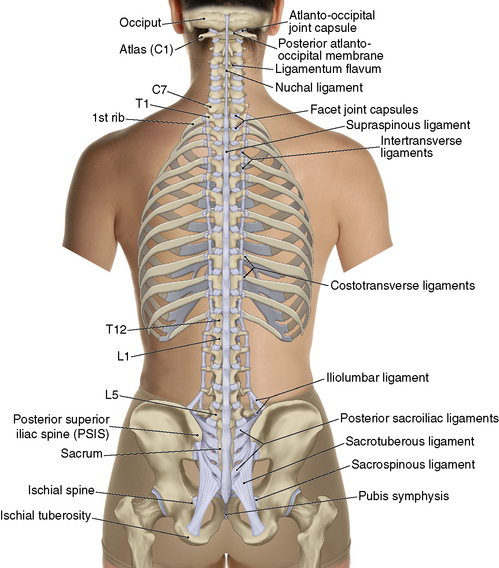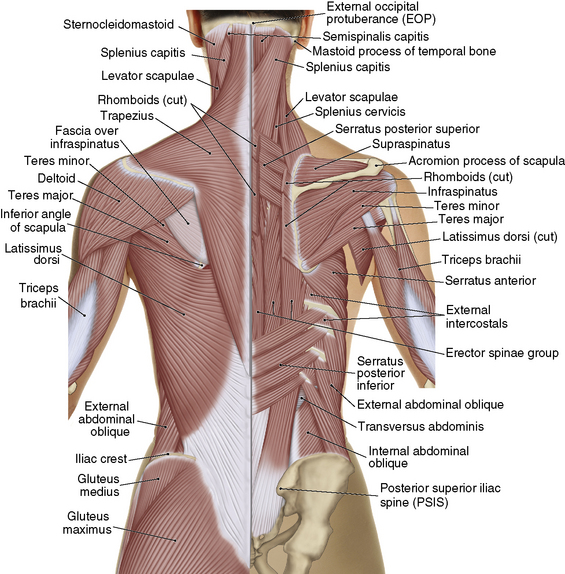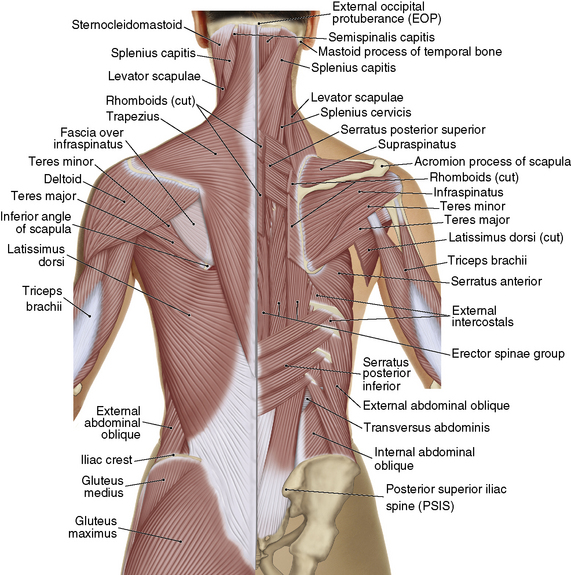Chapter 8 Back and Abdominals
1. Understand the anatomy of the thoracopelvic region.
2. Explain the muscular layers of the back.
3. Understand the natural curvatures of the spine.
4. Define the common postural distortions.
5. Understand the anatomy of the abdominal area.
6. Explain considerations about working with postural distortions.
Anatomy of the thoracopelvic region
Although this is not an anatomy text, it is important to review the anatomy of the thoracopelvic region to understand the complaints that clients express. The foundation of this area is composed of the vertebral spine, rib cage, pelvis, sacrum, and coccyx (Figure 8-1). It is structurally held together by a complex network of ligaments, fascia, tendons, and muscles. Multiple moving parts and the shape of this area make it more prone to injury, especially repetitive-movement disorders. Poor posture and incorrect body mechanics lead to trauma, repetitive injuries, stress disorders, and muscular pain.

Figure 8-1 Axial skeleton.
(From Muscolino JE: The muscle and bone palpation manual with trigger points, referral patterns, and stretching, St Louis, 2009, Mosby.)
The deepest layer consists of the postural muscles, which many therapists strive to address. These consist of the suboccipitals, transversospinalis group (multifidi, rotators, and semispinalis), and intercostalis muscles (Figure 8-2).

Figure 8-2 Deepest layer.
(From Muscolino JE: The muscle and bone palpation manual with trigger points, referral patterns, and stretching, St Louis, 2009, Mosby.)
The deep layer consists of the splenius (capitis, cervicis), levator scapulae, erector spinae group (iliocostalis, longissimus, spinalis), serratus posterior (superior and inferior). This is the area where most therapists spend their time working (Figure 8-3).

Figure 8-3 Deep layer.
(Right side) (From Muscolino JE: The muscle and bone palpation manual with trigger points, referral patterns, and stretching, St Louis, 2009, Mosby.)
The superficial layer consists of the trapezius, rhomboids, latissimus dorsi, and serratus anterior (Figure 8-4).

Figure 8-4 Superficial layer.
(Left side) (From Muscolino JE: The muscle and bone palpation manual with trigger points, referral patterns, and stretching, St Louis, 2009, Mosby.)
Postural distortions
Some of the causes of back discomfort can be directly related to postural distortions of some form. Postural distortions were discussed briefly in Chapter 2 about the assessment of the client. As discussed, hyperlordosis, hyperkyphosis, and scoliosis are distortions of concern. However, that chapter did not discuss how those distortions are created. Many therapists have been trained to think of these misalignments in the form of a linear positioning of the spine.
Stay updated, free articles. Join our Telegram channel

Full access? Get Clinical Tree








